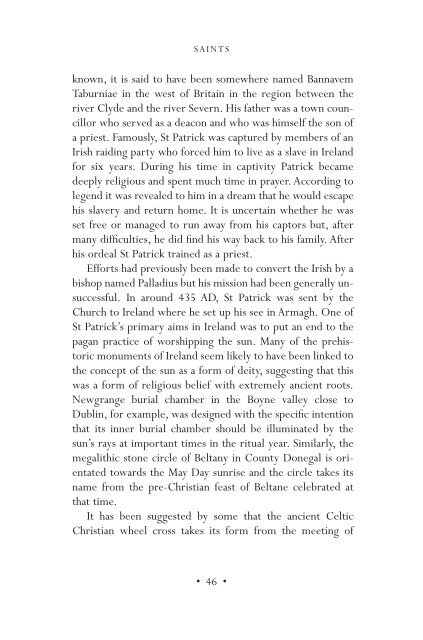02Knights Templar - Julian Emperor
02Knights Templar - Julian Emperor
02Knights Templar - Julian Emperor
Create successful ePaper yourself
Turn your PDF publications into a flip-book with our unique Google optimized e-Paper software.
SAINTS<br />
known, it is said to have been somewhere named Bannavem<br />
Taburniae in the west of Britain in the region between the<br />
river Clyde and the river Severn. His father was a town councillor<br />
who served as a deacon and who was himself the son of<br />
a priest. Famously, St Patrick was captured by members of an<br />
Irish raiding party who forced him to live as a slave in Ireland<br />
for six years. During his time in captivity Patrick became<br />
deeply religious and spent much time in prayer. According to<br />
legend it was revealed to him in a dream that he would escape<br />
his slavery and return home. It is uncertain whether he was<br />
set free or managed to run away from his captors but, after<br />
many difficulties, he did find his way back to his family. After<br />
his ordeal St Patrick trained as a priest.<br />
Efforts had previously been made to convert the Irish by a<br />
bishop named Palladius but his mission had been generally unsuccessful.<br />
In around 435 AD, St Patrick was sent by the<br />
Church to Ireland where he set up his see in Armagh. One of<br />
St Patrick’s primary aims in Ireland was to put an end to the<br />
pagan practice of worshipping the sun. Many of the prehistoric<br />
monuments of Ireland seem likely to have been linked to<br />
the concept of the sun as a form of deity, suggesting that this<br />
was a form of religious belief with extremely ancient roots.<br />
Newgrange burial chamber in the Boyne valley close to<br />
Dublin, for example, was designed with the specific intention<br />
that its inner burial chamber should be illuminated by the<br />
sun’s rays at important times in the ritual year. Similarly, the<br />
megalithic stone circle of Beltany in County Donegal is orientated<br />
towards the May Day sunrise and the circle takes its<br />
name from the pre-Christian feast of Beltane celebrated at<br />
that time.<br />
It has been suggested by some that the ancient Celtic<br />
Christian wheel cross takes its form from the meeting of<br />
•46•













